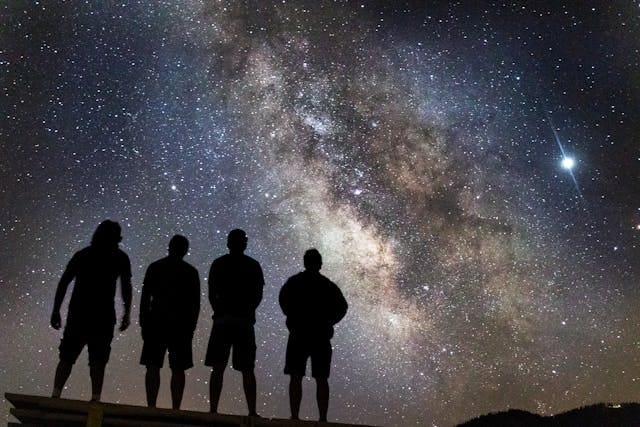The starry sky september 2025 is one to look forward to. The days are getting shorter, the nights longer, and that means more time to look up. Where August still revolved around the famous Perseids, September shifts the focus toward autumn constellations, a striking Milky Way and several planets that are easily visible. With the right preparation, you'll experience a sky full of highlights this month.
When is the night sky best visible in September?
In September, the nights get longer and darker. Around the new moon on september 21, 2025 the sky is most suitable for deep-sky observations: the Milky Way, star clusters and nebulae are then more visible without distracting moonlight.
Do you especially want to see the full moon and the spectacular lunar eclipse? Then you should Sept. 7, 2025 in your calendar. You can read more about the details in our separate blog Full moon September 2025.
What constellations will you see in September 2025?

September marks the transition from summer to autumn. As a result, you see both the familiar summer constellations and the first prominent autumn figures.
- The Summer Triangle: This is the triangle of Lyra (Lyre), Cygnus (Swan) and Aquila (Eagle). It still hangs high in the sky in September and remains a landmark for novice stargazers.
- Pegasus: The Autumn Square of Pegasus rises well in the evening, announcing the autumn sky.
- Andromeda: Next to Pegasus you will find the constellation Andromeda. Here lies the famous Andromeda galaxy (M31), our neighboring galaxy that is already visible with simple binoculars.
- Cassiopeia: With its W shape easy to spot in the north. Ideal to use as a guide to find Andromeda.
The Galaxy in September 2025
One of the most beautiful phenomena in the starry sky september 2025 is the Galaxy. This band of light still runs high through the south and zenith in September. In dark areas, you can see the cloud structures and star-rich areas with the naked eye.
With a binoculars the Milky Way really comes alive: numerous stars and some open clusters such as the Pleiades and the Double Cluster in Perseus become visible. With a Dobson telescope discover even more details: from the Lagoon Nebula to the Wild Duck Cluster.
👉 Consider a good astronomy binoculars if you want to look wide, or a Dobson telescope For the deep dive into nebulae and clusters.
Planets in September 2025
Planets play a starring role this month, although we have created a separate blog for extensive details: Moon and planets September 2025. Still, a brief overview of the most important ones:
- Jupiter: Shines brightly in the late evening and night. With a telescope, you can see its cloud bands and the four largest moons.
- Saturn: Still high in the sky and perfect for admiring the rings.
- Venus: Morning star on the eastern horizon, just before sunrise.
- Uranus and Neptune: Advanced and visible with telescope.
👉 For planetary observation, we recommend compact refractors or a Maksutov on, showing much detail at high magnifications.
Meteor swarms in September 2025
Although the big summer meteor showers are over, the starry sky september 2025 a few more smaller surprises:
- ε-Perseids: This swarm peaks in early September. Not as rich as the Perseids in August, but still good for some nice shooting stars per hour.
- Piscides: A lesser-known swarm that is active throughout September. It usually produces a handful of meteors per hour.
If you want a chance to spot a shooting star, look for a dark spot during peak nights.
Tips for stargazing in September 2025
1. Look with the naked eye
Recognizing constellations is easiest without tools. Use a star chart or an app like Stellarium!
2. Use binoculars
A 10×50 binoculars is ideal for exploring the Milky Way. You can also see open clusters such as the Pleiades and Hyades with it.
3. Set up a telescope
- Dobson telescopes are perfect for seeing deep-sky objects such as nebulae and star clusters.
- Refractor telescopes are useful for bright planets and the moon.
- Smart telescopes such as the Seestar S30, DWARF 3 or S50 automatically track objects and take pictures instantly - ideal if you want to capture the night sky as well.
4. Plan around the lunar phases
For deep-sky: around new moon (Sept. 21).
For lunar eclipse and moon observation: full moon Sept. 7.
Why September 2025 is a top month for stargazing
The starry sky september 2025 combines the best of two seasons: the legacy of the summer sky and the rise of the autumn constellations. With Jupiter and Saturn clearly visible, a beautiful Milky Way, minor meteor swarms and a total lunar eclipse, there is something special to see every night.
👉 Want to know which telescope is right for you? Check out our telescope selection guide.
Conclusion
September is the month to use your telescope or binoculars more often again. Whether you are enjoying the Summer Triangle, glancing at the rings of Saturn, or taking your first pictures of the Andromeda Galaxy, the sky is full of opportunities. Especially miss the nights around September 7 and Sept. 21 not.
Make stargazing September 2025 a month to remember, with the naked eye, binoculars or telescope.







